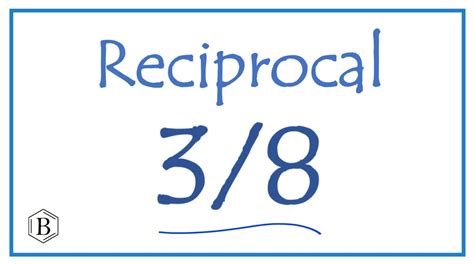What Is The Reciprocal Of 3 8
listenit
Mar 29, 2025 · 4 min read

Table of Contents
What is the Reciprocal of 3/8? A Deep Dive into Reciprocals and Their Applications
Understanding reciprocals is a fundamental concept in mathematics, particularly in algebra and arithmetic. This article explores the meaning of reciprocals, how to find them, and their practical applications, using the example of finding the reciprocal of 3/8.
What is a Reciprocal?
A reciprocal, also known as a multiplicative inverse, is a number which, when multiplied by the original number, results in a product of 1. In simpler terms, it's the number you need to multiply a given number by to get 1. This concept applies to various number types, including integers, fractions, and decimals.
Finding the Reciprocal of 3/8
Let's address the core question: what is the reciprocal of 3/8?
To find the reciprocal of a fraction, you simply switch the numerator and the denominator. The numerator becomes the denominator, and the denominator becomes the numerator.
Therefore, the reciprocal of 3/8 is 8/3.
Let's verify this:
(3/8) * (8/3) = (3 * 8) / (8 * 3) = 24/24 = 1
As you can see, multiplying 3/8 by its reciprocal, 8/3, results in 1, confirming that 8/3 is indeed the correct reciprocal.
Reciprocals of Other Number Types
The concept of reciprocals extends beyond fractions.
-
Integers: The reciprocal of an integer is simply 1 divided by that integer. For example, the reciprocal of 5 is 1/5, and the reciprocal of -2 is -1/2.
-
Decimals: To find the reciprocal of a decimal, first convert it into a fraction, then find the reciprocal of the fraction. For example, the reciprocal of 0.25 (which is 1/4) is 4/1 or 4.
-
Mixed Numbers: Convert the mixed number into an improper fraction before finding the reciprocal. For example, to find the reciprocal of 2 1/2 (which is 5/2), first convert 2 1/2 to an improper fraction (5/2) and then take the reciprocal which is 2/5.
The Importance of Reciprocals in Mathematics
Reciprocals play a crucial role in various mathematical operations and problem-solving:
-
Division: Dividing by a number is the same as multiplying by its reciprocal. This property is widely used to simplify calculations, particularly when dealing with fractions. For example, dividing 12 by 3/8 is the same as multiplying 12 by 8/3: 12 * (8/3) = 32
-
Solving Equations: Reciprocals are essential in solving equations where a variable is multiplied by a fraction or decimal. To isolate the variable, you multiply both sides of the equation by the reciprocal of the coefficient. For example, to solve the equation (3/8)x = 6, you would multiply both sides by 8/3: x = 6 * (8/3) = 16
-
Simplification of Expressions: Reciprocals help simplify complex algebraic expressions, often leading to more manageable forms.
Real-World Applications of Reciprocals
While the concept might seem purely mathematical, reciprocals have practical applications in various fields:
-
Engineering and Physics: Reciprocals are used extensively in calculations related to resistance, capacitance, and inductance in electrical circuits. In mechanics, they are involved in calculations of gear ratios and lever mechanics.
-
Chemistry: In stoichiometry, the concept of reciprocals is utilized for calculations involving mole ratios and chemical reactions.
-
Finance: Reciprocals can be applied in calculating interest rates and loan amortization schedules.
Common Mistakes to Avoid When Working with Reciprocals:
-
Forgetting the Reciprocal of 1: The reciprocal of 1 is 1. Students often make mistakes by incorrectly assigning a different reciprocal to 1.
-
Incorrectly Calculating Reciprocals of Negative Numbers: Remember that the reciprocal of a negative number is also negative. The reciprocal of -5 is -1/5.
-
Confusion with Inverse Operations: Reciprocals are multiplicative inverses, not additive inverses. The additive inverse of a number is its opposite (e.g., the additive inverse of 5 is -5).
Advanced Concepts and Extensions:
-
Reciprocals and Matrices: In linear algebra, the concept of reciprocals extends to matrices. The inverse of a matrix is a matrix that, when multiplied by the original matrix, results in the identity matrix (a matrix with 1s on the main diagonal and 0s elsewhere).
-
Reciprocals and Complex Numbers: Reciprocals can also be applied to complex numbers. The reciprocal of a complex number a + bi is calculated as (a - bi)/ (a² + b²).
Conclusion: Mastering the Reciprocal
Understanding the reciprocal is an important stepping stone for success in higher-level mathematics and its related applications. Through this article, we've explored the definition of a reciprocal, how to calculate it for various number types, its crucial role in mathematical operations, and its diverse applications across multiple disciplines. By practicing and understanding the nuances explained here, you can confidently handle reciprocal calculations and further enhance your mathematical proficiency. Remember, mastering the seemingly simple concept of reciprocals opens doors to more complex and fascinating areas of mathematical exploration. From basic arithmetic to advanced linear algebra, the significance of the reciprocal remains consistent and indispensable.
Latest Posts
Latest Posts
-
What Is 18 As A Fraction
Apr 02, 2025
-
13 Is 26 Of What Number
Apr 02, 2025
-
The Monomers Of Proteins Are Called
Apr 02, 2025
-
What Is 2 As A Fraction
Apr 02, 2025
-
Are Leading Zeros Significant If There Is A Decimal
Apr 02, 2025
Related Post
Thank you for visiting our website which covers about What Is The Reciprocal Of 3 8 . We hope the information provided has been useful to you. Feel free to contact us if you have any questions or need further assistance. See you next time and don't miss to bookmark.
